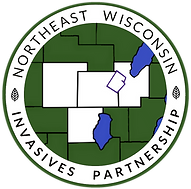

What are invasive species?
Terrestrial invasive species(TIS) are non-native plants, animals, and other living organisms that cause (or are likely to cause) economic or environmental harm.
These species are usually unintentionally spread by human activities from foreign ecosystems. Invasive species can establish very rapidly to out-compete native species and permanently alter habitats.
Common buckthorn is one of the most established invasive species in Wisconsin.
Why protect native species?
Native species provide many benefits to an ecosystem. Most notably, native plants conserve water, improve soil health, and provide food for wildlife. Native species can create a more balanced ecosystem.
Wildlife species have adapted to living in ecosystems with native vegetation. Native plants provide foliage, tubers, and fruit to wildlife that can effectively be digested.

Bloodroot is a spring ephemeral native to Wisconsin.
_JPG.jpg)
Butterfly weed is a native plant to Wisconsin and very important to pollinators.


NEWIP can treat invasive plants on your property!
If you're interested in this service, please contact the NEWIP coordinator at newinvasives@gmail.com
Note: Service may include fees.
Additional information on invasive species:
Midwest Invasive Plant Network (MIPN)
MIPN is a regional group who shares information about invasive plant management to reduce the impact of invasives in the Midwest.
Invasive Plants Association of Wisconsin (IPAW)
IPAW is a statewide group dedicated to invasive plant education and management.
WIFDN is a group within the University of Wisconsin Division of Extension that engages volunteers to monitor invasive species.
Wisconsin First Detector Network (WIFDN)
Wisconsin Department of Natural Resources (WiDNR)
The WiDNR provides information about invasive species state laws and management.
IPAW is a statewide group dedicated to invasive plant education and management.
